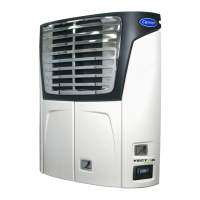62-11785 8–8
g. Adding a Complete Charge
1. Evacuate unit and leave in deep vacuum. (Refer to Section 8.5.4.)
2. Determine charge required for this unit (refer to the model/serial number nameplate or
Table 2–1
) and procure a
refrigerant cylinder with sufficient weight of refrigerant. Place cylinder on scale and connect charging line from
cylinder to liquid line service valve.
3. Note weight of cylinder and refrigerant.
4. Open the liquid valve on cylinder. Midseat liquid line service valve and allow liquid refrigerant to flow into the unit
until the correct weight of refrigerant has been added.
It is possible that all the required liquid may not be pulled into the receiver, as outlined in step 4. In this
case, add the additional refrigerant in accordance with the charge adjustment procedures, refer to pre-
ceding step f.
5. When scale indicates the correct charge has been added, close liquid valve on cylinder and backseat the liquid
line service valve. Remove charging hose.
6. Start unit and run Pretrip to check operation.
8.5.3 Leak Checking
Never use air or gases containing oxygen for leak testing or operating refrigerant compres-
sors. Pressurized mixtures of air or gases containing oxygen can lead to explosion.
The condition that the system may be in when leak checking is required include; when the system is charged,
when the system is without charge, when the low side has been pumped down and when only the compressor is to
be leak checked. Procedures for each condition are provided in the following subsections.
a. Leak Checking a Charged System
1. Ensure the unit will not start automatically by placing the START/RUN-OFF switch in the OFF position. Dis-
connect the high voltage source and lockout/tagout the receptacle.
Service Mode is not required for this procedure.
2. Verify that the suspected leak area (high side or low side) has sufficient pressure (minimum 20 psig = 1.4 bar) to
detect the leak. The larger the leak the less pressure is required. The smaller the leak, the greater the pressure
required.
3. The recommended procedure for finding leaks from a system is with an electronic leak detector. Checking joints
with soapsuds is satisfactory only for locating large leaks, or pinpointing small leaks once a general area has
been located.
4. Some leaks may be repaired by simply tightening a connection. Others may require removal of the charge, refer
to
Section 8.5.2
.
5. Start unit and run Pretrip to check operation.
b. Leak Checking a System Without Charge
The refrigeration system must be leak checked once it is closed and all repairs complete.
1. Ensure the unit will not start automatically by disabling any two way communication and placing the START/
RUN-OFF switch in the OFF position. Disconnect the high voltage source and lockout/tagout the receptacle.
2. Connect refrigerant system equipment if not already connected. Refer to
Figure 8.4
.

